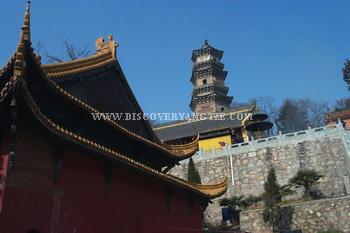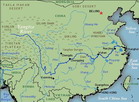2020 Yangtze River Cruise and Ferry Starting from 79 USD p.p.!
Wuhu Introduction
Wuhu, on the south bank of the river,
is in southeastern Anhui Province at the confluence
of the Qingyt and Yangtze Rivers. Its population
is only 440,000, not large by Chinese standards.
ln the last century, Wuhu was one of the four
great rice- marketing centres (the others being
Wuxi, Jiujiang and Changsha), but it is now
principally a producer of light-industrial goods,
such as thermos flasks, machine tools, cotton
textiles, kitschy mantelpiece clocks and cement.
It is specially known for its scissors, its
variety of local twig and leaf brooms and its
wrought-iron pictures.
the Qingyt and Yangtze Rivers. Its population
is only 440,000, not large by Chinese standards.
ln the last century, Wuhu was one of the four
great rice- marketing centres (the others being
Wuxi, Jiujiang and Changsha), but it is now
principally a producer of light-industrial goods,
such as thermos flasks, machine tools, cotton
textiles, kitschy mantelpiece clocks and cement.
It is specially known for its scissors, its
variety of local twig and leaf brooms and its
wrought-iron pictures.
As a good transportation system
links Wuhu with other parts of the province,
the city is a transfer stop for visitors to
the famous scenic spots of Huangshan and Jiuhua.However,
this is the farthest up the Yangtze River valley
you can travel by train from Shanghai and Nanjing.
From here the train line travels north to Hefei.
HISTORY OF WUHU
In the Spring and Autumn period
(770--476 BC) the city was known as Jiuzi. Its
present name was adopted in the Han dynasty
(206 BC--AD 220). By the Three Kingdoms period
(220--65 AD, see page 42) it had become a strategically
important town in the Kingdom of Eastern Wu.
In a fierce battle between the Kingdoms of Eastern
Wu and Shu, the Wu general Zhou Yu was killed.
The King of Wu, Sun Quan,donned white mourning
clothes and made a special journey to Wuhu to
receive Zhou Yu's coffin.
In the Tang dynasty (618--907) the
poet Du Fu's many visits were recollected in
his poem, Thoughts on Staying Again at Wuhu.
When Wuhu became a Treaty Port under the Chefoo
(Yan Tai) Convention of 1876 a small foreign
community resided here. Trading principal1y
in rice, wood and tea, it had become a flourishing
commercial port by the end of the l9th century.
Trade dropped off severely in the l920s and
l930s due to bandit activity in the area. When
the city was captured by the Guomindang army
in March 1927, anti-foreign riots broke out.
The foreign community had to be evacuated by
warships patrolling the Yangtze.
WHAT TO SEE IN WUHU
There is little of historical interest
to be found in Wuhu, but a stroll along the
east embankment of the Qingyi River is worthwhile.
Here barges and small boats load and discharge
vegetables, fruit, sand and everyday items;
boat families and their pets add to the cacophony
of noise. Bamboo rafts, at intervals along the
river's edge, serve as platforms for, the local
women to do their washing. In the narrow streets
parallel to the river, such as ZhongchangJie
and ShangchangJie, shops sell fishing tackle
and nets, baskets, firecrackers, bamboo steamers,
and Chinese weights and measure.In the cobbled
streets, bamboo chicken coops stand outside
front doors that open into dark, high--ceilinged
old houses. xinwu Jie running west off the main
street,Zhongshan Jie, is busy with restaurants
and food stalls serving crispy rice cakes,sweet
dumpling soup and large dough fritters. Near
the scruffy memorial to the 1949 Revolution
is Jiuhe Jie, which is now a market area. At
No 26 a huge, fanciful,American--built Catholic
Church, dating from the Treaty Port days, is
open for worship on Sundays. At Jinghu
Lake, in the town centre, people gather
to play cards or chess and to sell their miniature
potted plants.
ZHE HILL
The highest point in the city is
only 86 metres (282 feet), but the view from
the pagoda at the top sweeps over the whole
city and down the Yangtze. It seems that this
five-storey Zheshan Pagoda and the Mid-River
Pagoda (see below) were built at the same time,
at the beginning of the Song dynasty (960--1279).
A competition apparently developed between the
two teams of builders. The two brothers engaged
in the construction of Zheshan Pagoda, who were
desperate to cornplete first and so avoid losing
face, finished off the very top with a cooking
wok turned upside down.A small zoo is to be
found in the public park.
top sweeps over the whole
city and down the Yangtze. It seems that this
five-storey Zheshan Pagoda and the Mid-River
Pagoda (see below) were built at the same time,
at the beginning of the Song dynasty (960--1279).
A competition apparently developed between the
two teams of builders. The two brothers engaged
in the construction of Zheshan Pagoda, who were
desperate to cornplete first and so avoid losing
face, finished off the very top with a cooking
wok turned upside down.A small zoo is to be
found in the public park.
GUANGJI TEMPLE
Of the four main temples which existed
in Wuhu, three were destroyed in the Sino-Japanese
War and only the Guanaii Temple, at the foot
of Zhe Hill, remains. The main hall is hung
with ten scrolls depicting the Buddhist Hell.
The temple was
established in the Tang dynasty (618--907) and
Emperor Dezong (reigned 780--5) came here as
a monk. When omens indicated that this was an
unsafe place for him to reside, he went to live
on the famous Buddhist mountain of Jiuhua, further
south.
MID--RIVER PAGODA
This six-storey pagoda stands at
the point where the Qingyi River enters the
Yangtze,a danger  spot for navigation. A local
fisherman named Huang suggested that this octagonal
pagoda be built to serve as a lighthouse. Its
name derives from its position--it is exactly
in the middle of the lower reaches of the Yangtze.
spot for navigation. A local
fisherman named Huang suggested that this octagonal
pagoda be built to serve as a lighthouse. Its
name derives from its position--it is exactly
in the middle of the lower reaches of the Yangtze.
WUHU ARTS AND CRAFTS FACTORY
The art of wrought-iron picture-making
originated in Wuhu and this factory in Jiuhua
Lu continues the tradition, besides producing
pictures made of feathers or golden wheat stalks,
poker-burned wooden decorations and copies of
old paintings.
Iron picture making is very laborious
and amazingly intricate This art form was started
by an itinerant blacksmith, Tang Tianchi, during
the reign of Emperor Kangxi (1662--1723). Tang
used to sit and watch a local painter, whose
work he much admired. The artist chided Tang:
I paint my pictures, you beat your iron, but
you will never make pictures by beating iron.'
Tang promptly went away and produced an iron
picture, 'using a hammer as a brush and iron
as ink'.
A huge 'Welcoming Pine' iron picture
by the artists of Wuhu adorns the Anhui Room
in the Great Hall of the People in Bejing.



